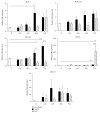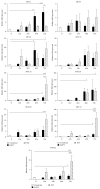Differential mucin expression by respiratory syncytial virus and human metapneumovirus infection in human epithelial cells
- PMID: 25977598
- PMCID: PMC4421075
- DOI: 10.1155/2015/347292
Differential mucin expression by respiratory syncytial virus and human metapneumovirus infection in human epithelial cells
Abstract
Mucins (MUC) constitute an important component of the inflammatory and innate immune response. However, the expression of these molecules by respiratory viral infections is still largely unknown. Respiratory syncytial virus (RSV) and human metapneumovirus (hMPV) are two close-related paramyxoviruses that can cause severe low respiratory tract disease in infants and young children worldwide. Currently, there is not vaccine available for neither virus. In this work, we explored the differential expression of MUC by RSV and hMPV in human epithelial cells. Our data indicate that the MUC expression by RSV and hMPV differs significantly, as we observed a stronger induction of MUC8, MUC15, MUC20, MUC21, and MUC22 by RSV infection while the expression of MUC1, MUC2, and MUC5B was dominated by the infection with hMPV. These results may contribute to the different immune response induced by these two respiratory viruses.
Figures


Similar articles
-
Human metapneumovirus induces more severe disease and stronger innate immune response in BALB/c mice as compared with respiratory syncytial virus.Respir Res. 2007 Jan 29;8(1):6. doi: 10.1186/1465-9921-8-6. Respir Res. 2007. PMID: 17257445 Free PMC article.
-
Respiratory Syncytial Virus and Human Metapneumovirus Infections in Three-Dimensional Human Airway Tissues Expose an Interesting Dichotomy in Viral Replication, Spread, and Inhibition by Neutralizing Antibodies.J Virol. 2020 Sep 29;94(20):e01068-20. doi: 10.1128/JVI.01068-20. Print 2020 Sep 29. J Virol. 2020. PMID: 32759319 Free PMC article.
-
Differential Responses of Pediatric and Adult Primary Epithelial Cells to Human Metapneumovirus and Respiratory Syncytial Virus Infection.Viruses. 2025 Mar 6;17(3):380. doi: 10.3390/v17030380. Viruses. 2025. PMID: 40143308 Free PMC article.
-
Non-Coding RNAs and Their Role in Respiratory Syncytial Virus (RSV) and Human Metapneumovirus (hMPV) Infections.Viruses. 2020 Mar 21;12(3):345. doi: 10.3390/v12030345. Viruses. 2020. PMID: 32245206 Free PMC article. Review.
-
The distinguishing features of human metapneumovirus and respiratory syncytial virus.Rev Med Virol. 2010 Jul;20(4):245-60. doi: 10.1002/rmv.651. Rev Med Virol. 2010. PMID: 20586081 Review.
Cited by
-
MUC1-C influences cell survival in lung adenocarcinoma Calu-3 cells after SARS-CoV-2 infection.BMB Rep. 2021 Aug;54(8):425-430. doi: 10.5483/BMBRep.2021.54.8.018. BMB Rep. 2021. PMID: 33832550 Free PMC article.
-
Upregulation of cell-surface mucin MUC15 in human nasal epithelial cells upon influenza A virus infection.BMC Infect Dis. 2019 Jul 15;19(1):622. doi: 10.1186/s12879-019-4213-y. BMC Infect Dis. 2019. PMID: 31307416 Free PMC article.
-
Cell-Mediated Responses to Human Metapneumovirus Infection.Viruses. 2020 May 14;12(5):542. doi: 10.3390/v12050542. Viruses. 2020. PMID: 32423043 Free PMC article. Review.
-
MUC22, HLA-A, and HLA-DOB variants and COVID-19 in resilient super-agers from Brazil.Front Immunol. 2022 Oct 25;13:975918. doi: 10.3389/fimmu.2022.975918. eCollection 2022. Front Immunol. 2022. PMID: 36389712 Free PMC article.
-
Mucosal Immune Responses to Respiratory Syncytial Virus.Cells. 2022 Mar 29;11(7):1153. doi: 10.3390/cells11071153. Cells. 2022. PMID: 35406717 Free PMC article. Review.
References
-
- Rose M. C. Mucins: structure, function, and role in pulmonary diseases. American Journal of Physiology—Lung Cellular and Molecular Physiology. 1992;263(4):L413–L429. - PubMed
Publication types
MeSH terms
Substances
Grants and funding
LinkOut - more resources
Full Text Sources
Other Literature Sources
Research Materials
Miscellaneous

